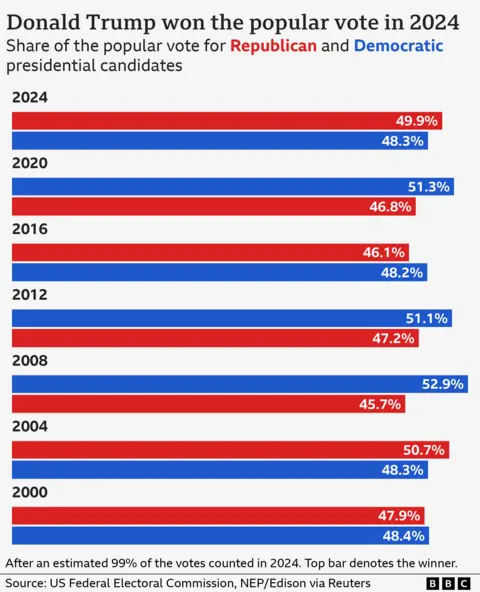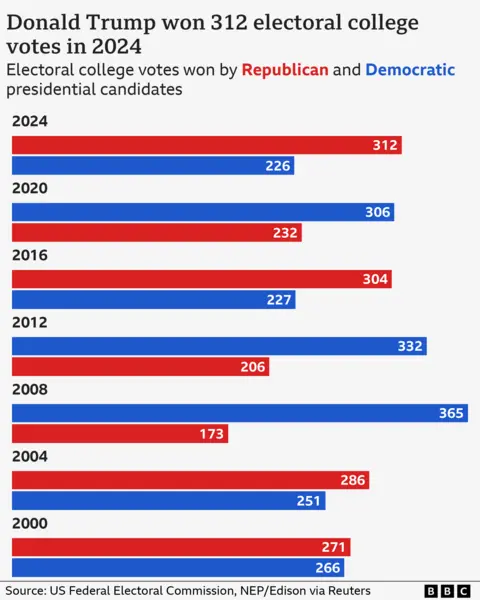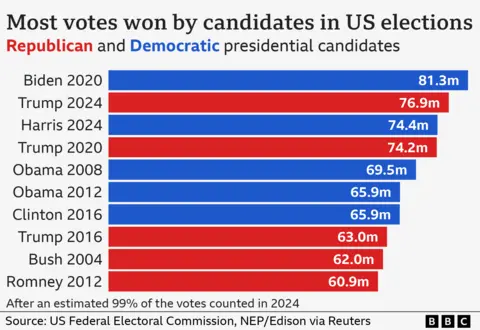Just how big was Donald Trump’s election victory?

Republican President-elect Donald Trump has said his election victory handed him an “unprecedented and powerful” mandate to govern.
He beat Democratic rival Kamala Harris in all seven closely watched swing states, giving him a decisive advantage overall.
Trump’s party has also won both chambers of Congress, giving the returning president considerable power to enact his agenda.
He has broadened his appeal across nearly all groups of voters since his 2020 defeat. And in doing so he pulled off a comeback unmatched by any previously defeated president in modern history.
But the data suggests it was a much closer contest than he and his allies are suggesting.
His communications director Steven Cheung has called it a “landslide” victory. Yet it emerged this week that his share of the vote has fallen below 50%, as counting continues.
“It feels grandiose to me that they’re calling it a landslide,” said Chris Jackson, senior vice-president in the US team of polling firm Ipsos.
The Trump language suggested overwhelming victories, Jackson said, when in fact it was a few hundred-thousand votes in key areas that propelled Trump back to the White House.
That is thanks to America’s electoral college system, which amplifies relatively slender victories in swing states.
Here are three ways to look at his win.
Trump missed majority of voters by a hair
With 76.9 million votes and counting, Trump won what is known as the popular vote, according to the latest tally by the BBC’s US partner, CBS News.
That means he scored more votes than Harris (74.4 million), or any other candidate. No Republican has managed that feat since 2004.
But as vote-tallying continues in some parts of the US, he has now slipped a fraction of a percentage point below 50% in his vote share. He is not expected to make up the gap as counting goes on in places like Democratic-leaning California.
This was also the case in 2016, when Trump beat Hillary Clinton to the presidency despite losing the popular vote – having notched only 46% of the overall ballots cast.

In 2024, Trump’s win of both the popular vote and the presidency can be seen as an improvement on his last victory eight years ago.
But Trump cannot say that he won the outright majority of the presidential votes that were cast in the election overall.
To do so, he would need to have won more than 50%, as all victors have done for the last 20 years – other than Trump in 2016.
For this reason, his claim to have a historic mandate “may be overwrought”, suggested Chris Jackson of polling firm Ipsos, who said the language of Trump and his supporters was a tactic being used to “justify the sweeping actions they’re planning to take once they have control of the government”.
His electoral college win was resounding
On a different metric, Trump’s win over Harris in 2024 appears more comfortable. He won 312 votes in the US electoral college compared with Harris’s 226.
And this is the number that really matters. The US election is really 50 state-by-state races rather than a single national one.
The winner in any given state wins all of its electoral votes – for example, 19 in swing state Pennsylvania. Both candidates hoped to reach the magic number of 270 electoral votes to earn a majority in the college.
Trump’s 312 is better than Joe Biden’s 306 and beats both Republican wins by George W Bush. But it is well shy of the 365 achieved by Barack Obama in 2008 or the 332 Obama won getting re-elected, or the colossal 525 by Ronald Reagan in 1984.
And it is important to remember that the “winner takes all” mechanic of the electoral college means that relatively slender wins in some critical areas can be amplified into what looks like a much more resounding triumph.

Trump is ahead by just over 230,000 votes in Michigan, Pennsylvania and Wisconsin, according to the latest numbers from CBS. All three states were the focus of intensive campaigning by both parties ahead of the 5 November vote.
If just over 115,000 voters in that group had instead picked Harris, she would have won those Rust Belt swing states, giving her enough votes in the electoral college to win the presidency.
That might sound like a lot of people but the number is a drop in the ocean of the more-than-150 million votes that were cast nationwide.
In other swing states in the Sun Belt – namely Arizona, Georgia, Nevada and North Carolina – the margins of victory for Trump were much more comfortable.
But when looking at the power wielded by the Republicans more broadly, their majority in the US House, the lower chamber of Congress, remains slender.
Second highest vote count – behind Biden in 2020
There is another measure with which to consider Trump’s win, which is to look at the number of votes he received, although this is a relatively crude measure.
The 76.9 million that he has amassed so far is the second-highest tally in American history.

It is important to remember that the US population, and therefore the electorate, is constantly growing. The more-than-150 million people who voted in the US this year is more than double the number of 74 million who went to the polls in 1964.
That makes comparisons through time tricky. But it was only four years ago that the record haul was achieved.
Biden won 81.3 million votes on his way to the White House in 2020 – a year of historic voter turnout when Trump was again on the ticket.
Although the Republicans made important breakthroughs in 2024, the Democrats also failed to connect with voters, said Jackson, who put the trend down to Americans’ wish to return to “2019 prices” after a years-long cost-of-living squeeze.
“The real story is Harris’s inability to mobilise people who voted for Biden in 2020,” he said.
Comments (0)